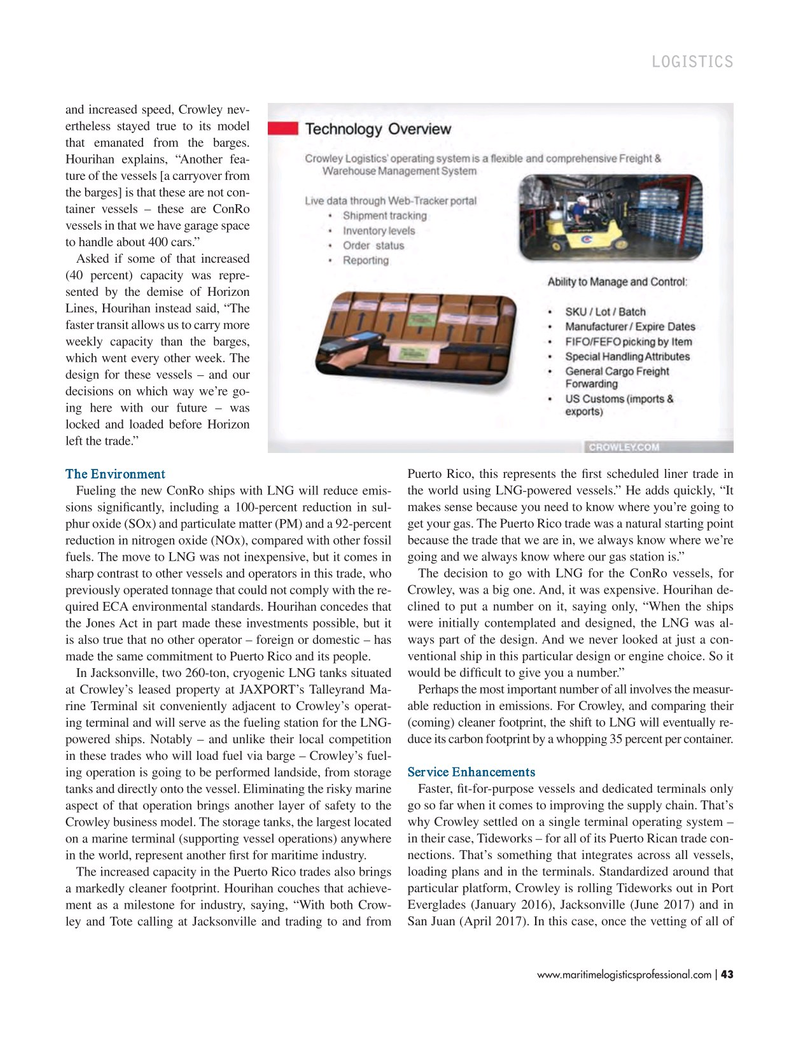
Page 43: of Maritime Logistics Professional Magazine (May/Jun 2017)
BUNKER OPERATIONS & PORTS
Read this page in Pdf, Flash or Html5 edition of May/Jun 2017 Maritime Logistics Professional Magazine
LOGISTICS and increased speed, Crowley nev- ertheless stayed true to its model that emanated from the barges.
Hourihan explains, “Another fea- ture of the vessels [a carryover from the barges] is that these are not con- tainer vessels – these are ConRo vessels in that we have garage space to handle about 400 cars.”
Asked if some of that increased (40 percent) capacity was repre- sented by the demise of Horizon
Lines, Hourihan instead said, “The faster transit allows us to carry more weekly capacity than the barges, which went every other week. The design for these vessels – and our decisions on which way we’re go- ing here with our future – was locked and loaded before Horizon left the trade.”
The Environment Puerto Rico, this represents the frst scheduled liner trade in
Fueling the new ConRo ships with LNG will reduce emis- the world using LNG-powered vessels.” He adds quickly, “It sions signifcantly, including a 100-percent reduction in sul- makes sense because you need to know where you’re going to phur oxide (SOx) and particulate matter (PM) and a 92-percent get your gas. The Puerto Rico trade was a natural starting point reduction in nitrogen oxide (NOx), compared with other fossil because the trade that we are in, we always know where we’re fuels. The move to LNG was not inexpensive, but it comes in going and we always know where our gas station is.” sharp contrast to other vessels and operators in this trade, who The decision to go with LNG for the ConRo vessels, for previously operated tonnage that could not comply with the re- Crowley, was a big one. And, it was expensive. Hourihan de- quired ECA environmental standards. Hourihan concedes that clined to put a number on it, saying only, “When the ships the Jones Act in part made these investments possible, but it were initially contemplated and designed, the LNG was al- is also true that no other operator – foreign or domestic – has ways part of the design. And we never looked at just a con- made the same commitment to Puerto Rico and its people. ventional ship in this particular design or engine choice. So it
In Jacksonville, two 260-ton, cryogenic LNG tanks situated would be diffcult to give you a number.” at Crowley’s leased property at JAXPORT’s Talleyrand Ma- Perhaps the most important number of all involves the measur- rine Terminal sit conveniently adjacent to Crowley’s operat- able reduction in emissions. For Crowley, and comparing their ing terminal and will serve as the fueling station for the LNG- (coming) cleaner footprint, the shift to LNG will eventually re- powered ships. Notably – and unlike their local competition duce its carbon footprint by a whopping 35 percent per container.
in these trades who will load fuel via barge – Crowley’s fuel- ing operation is going to be performed landside, from storage Service Enhancements tanks and directly onto the vessel. Eliminating the risky marine Faster, ft-for-purpose vessels and dedicated terminals only aspect of that operation brings another layer of safety to the go so far when it comes to improving the supply chain. That’s
Crowley business model. The storage tanks, the largest located why Crowley settled on a single terminal operating system – on a marine terminal (supporting vessel operations) anywhere in their case, Tideworks – for all of its Puerto Rican trade con- in the world, represent another frst for maritime industry. nections. That’s something that integrates across all vessels,
The increased capacity in the Puerto Rico trades also brings loading plans and in the terminals. Standardized around that a markedly cleaner footprint. Hourihan couches that achieve- particular platform, Crowley is rolling Tideworks out in Port ment as a milestone for industry, saying, “With both Crow- Everglades (January 2016), Jacksonville (June 2017) and in ley and Tote calling at Jacksonville and trading to and from San Juan (April 2017). In this case, once the vetting of all of www.maritimelogisticsprofessional.com 43
I

 42
42

 44
44
